The Ksar of Ait Benhaddou is one of the most famous architectural structures in all of Morocco. You may well have seen it when searching the internet while planning your trip to Morocco. So perhaps you are already wondering about the Ksar or Kasbah of Ait Benhaddou.
This article will answer all of your questions, provide helpful advice, and discuss:
The Ksar of Ait Benhaddou A Little Background; Art, Cinema, and History: How to visit Ait Benhaddou on your own; How to visit Ait Benhaddou in a Planned, Organised Group; Where to stay in Ait Benhaddou; Where to eat in Ait Benhaddou.
One of the reasons for the great popularity of Ait Benhaddou is because it was the setting for many famous films and television series such as Lawrence of Arabia, The Mummy, Gladiator, Prince of Persia, and Game of Thrones in which it was the city of Yunkai. It remains popular with Hollywood filmmakers and in 2023 was the setting for parts of the yet-to-be-released Gladiator II.
First of all, what is the difference between a Kasbah and a Ksar?
A Kasbah is a single, walled castle in which a wealthy and powerful family lived. Whereas a Ksar is a fortified town, a kind of giant fortress, that contains many distinct buildings. Therefore, a Ksar may include many separate Kasbahs inside its borders. Thus, Ait Benhaddou is a Ksar.
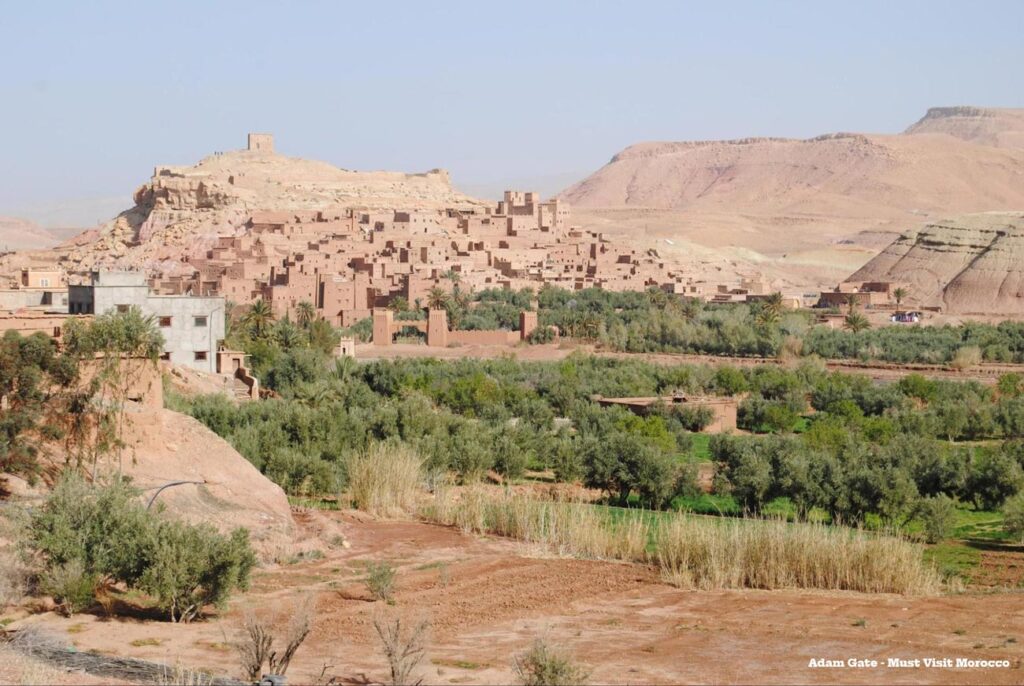
The Ksar of Ait BenHaddou
The Ksar of Ait BenHaddou derives its name from the Haddou tribe that ruled the region and started building on the hill by the river in the 17th century. As for the meaning of Ben, it means sons or sons of Haddou. They profited from the slope of the hill to construct small houses made of mudbrick mixed with straw and clay. Some are rather simple and others appear more like real palaces or Kasbahs. It was a site visited frequently by the caravans of tradesmen who followed the pathway between Marrakech and the cities on that side of the Sahara, in a journey that took many months.
As time passed, the castle became almost deserted, even though many of its structures were preserved almost untouched, making it one of the most perfect examples of mediaeval, Berber pre-Saharan architecture.
It is one of the wonders of Morocco that deserves admiration for three main reasons:
- The first one is the fact that it was appointed a UNESCO World Cultural Heritage site in 1987. This recognizes its historic and cultural significance.
- The second reason is that it has been the location for several big-budget films and television series.
- The third reason is its iconic look and the fact that it is breathtakingly beautiful.
Ait Benhaddou is the most famous “walled town” or Ksar in Morocco. Located near the city of Ouarzazate in the Draa Tafilalet area of Southern Morocco, this Ksar, or walled mud-brick town, is a popular tourist attraction for both Moroccans and foreign visitors In addition to being the site for the shooting of several cinematographic masterpieces, it is a prime example of ancient Moroccan construction techniques. It is also an example of a Moroccan town built on the fringes of the vast Sahara desert, the largest hot desert in the world.
A Little Background:
The Ksar or walled villages with their clay and mud-brick houses stopped being built over time as other, more modern and sturdy methods of construction replaced them. The ones that remain are like a marvellous time machine that offers a glimpse into an age now gone. The towns were created to administer the crops and the palm forests that were planted along the isolated rivers near the desert. Ksars are often square or rectangular confined enclosures with watch towers at the four corners. Inside the walls, small houses, playgrounds, and pathways were built.
Ait Benhaddou can be found 30 kilometres before arriving at Ouarzazate on the way from Marrakech, is one of the best-preserved ksars in the country and has undergone some renovation as a result of UNESCO’s granting it World Cultural Heritage status. Thanks to the grandeur of its Berber buildings, in the complex maze of pathways and concealed paths that can be visited after passing the Ounila River on muleback or foot, there still exists the untouched attraction of its roots, when this Ksar was a gateway to and from the desert for a multitude of caravans; travellers with camels packed with valuable products.
Art, Cinema and History:
The cinema has played an important role in recreating and reshaping the image of Ait Benhaddou and making it famous by using it as a setting for many films and TV series such as The Jewel of the Nile, Sodom and Gomorrah, Gladiator, and some scenes of Lawrence of Arabia. The seventh art, as cinema is sometimes called, may have played a role in this fame, but the prime reason is its charm which no one visiting the place can deny.
In the village, you will notice Moroccan handicrafts of different kinds; clay pots, iron tools, leather belts, woollen goods, hand-blown glass, and other beautiful items. Ait Benhaddou is an outstanding illustration of southern Moroccan construction, whose history goes back nearly a thousand years.
Ait Benhaddou became wealthy, powerful, and prosperous due to being a compulsory stop for the caravans passing along the trade routes, the taxes it levied, and money earned from the visitors who stayed there. It was a necessary stop on the route across the Sahara, a link connecting The Sudan with the imperial city of Marrakech, via Telouet. The camels brought gold, silver, silks, and spices amongst other riches, and returned packed with salt.
Thousands of people inhabited this walled city at its height. It contained small castles, a large open public area, mosques, hostels for travellers, a store at the top of the village, and two burial grounds; one for Muslims and one for Jews.
Eventually, the caravans began to dwindle in size and frequency and the populace of Ait Benhaddou decreased over the years. Today only a few families dwell in the fortified enclosure, the majority of the families, even the shop owners and tour guides, reside in the new town built in modern style on the other side of the river. Despite such retrogression, the town’s essential splendour persists; the crimson buildings that merge with the earth, the traditional mud and straw houses, amid other distinctive and rare features of the area.
Disappearing into this mud-brick maze is an amazing adventure. It is like going back into the past, merely by walking through the streets you will sense the echoes of ancient times. It is also wonderful to see the beautiful scenery surrounding the town, from the kasbah at the top, you can observe the whole sub-Saharan area and, in the distance, the snow-covered summits of the High Atlas Mountains.
You can visit Ait Benhaddou by yourself or rent an official guide, experienced and English-speaking, to escort you through the twisting alleyways and tell you about its history. But if you do want to hire a guide, it is recommended to check the price before beginning your trip. There are faux guides about looking for unsuspecting tourists to scam. To ensure you get a genuine guide, you can enquire about them at the reception of any of the hotels or guest houses in the new town.
It is definitely recommended for any trip to southern Morocco to explore the Kasbah of Ait Benhaddou carefully, entering the houses and examining the lifestyle, culture, and art of a bygone age.
How to Visit Ait Benhaddou on Your Own
Ait Benhaddou is separated into two parts:
The ancient city (the well-known Ksar) and the modern city on the opposite side of the river, unremarkable in itself, but with many hotels and restaurants. It is situated about 30 km from Ouarzazate at the southern end of the Ounila Valley, which goes across charming countryside along the way to Marrakech and passes by the wonderful Telouet Kasbah.
Until a few years ago, the track was just a dirt road, but now it has been asphalted and is in good condition for fast motor vehicle access. This is sensibly the only way to access Ait Benhaddou.
The ancient citadel is cut off from the modern city by the Ounila River. In order to reach its feet, you will have to cross the river by walking over the footbridge or crossing via stepping stones covered in sacking, not too difficult as the river is usually low or nearly dry.
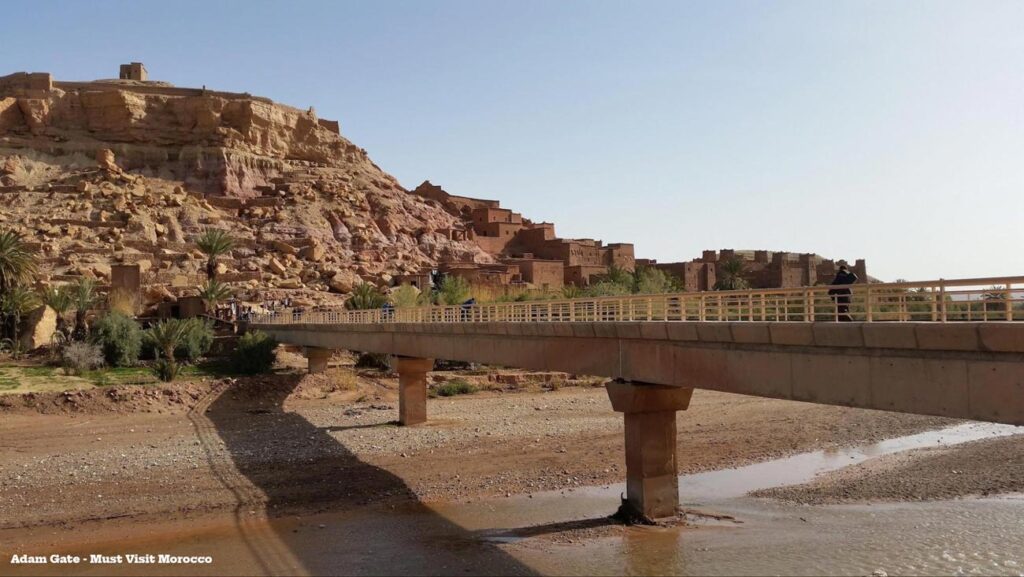
You can park your car in a parking spot near the hostel or on the main street of the modern town. There are two places to pass over the river:
- Over the recently erected footbridge which is located at the back of the mosque.
- Descending the lane to the La Terrazza restaurant and from there jumping over the sacking-covered paving stones over the river, There are usually young men and boys to help more unsteady visitors for a small tip. In summer, the river is usually dry and one may just walk across.
There are three ways of passing through the old walls to enter the Kasbah. Firstly, and the one we make use of on our trips, is by crossing the new bridge on the left-hand side. Alternatively, there is a gate in the middle of the wall. This route passes between the most amazing buildings. It is located on the left, shortly beyond the stepping stones over the river.
The third means of access is also found after passing over the river via the stones but by taking a right after that. This is a pathway near a small oasis that leads into an entrance alleyway. The entry point is free of charge. We were told that being charged an entrance fee depends on where you get in, if you walk through the main central entrance, you will pass through a private house. The owners might demand some money, but if so it will only be about 20 Dhs (about $2) (as they said to us at the hotel reception).
We always enter across the footbridge and depart from the one in the middle and no one has ever requested any money. But we can’t say for certain if you have to pay money if you enter from the middle or even from the right.
As soon as you are inside the walls, you will notice that Ait Benhaddou appears as a collection of stone-paved streets with tiny houses on each side, generally unoccupied, and many with the ground floors converted into shops. There are many flights of steps for ascending the hill. It isn’t a labyrinth so you won’t get lost. But it is a fair climb to arrive at the Agadir that tops the hill and then there is the descent, which, where possible, is best done by passing through different streets and exiting by another door.
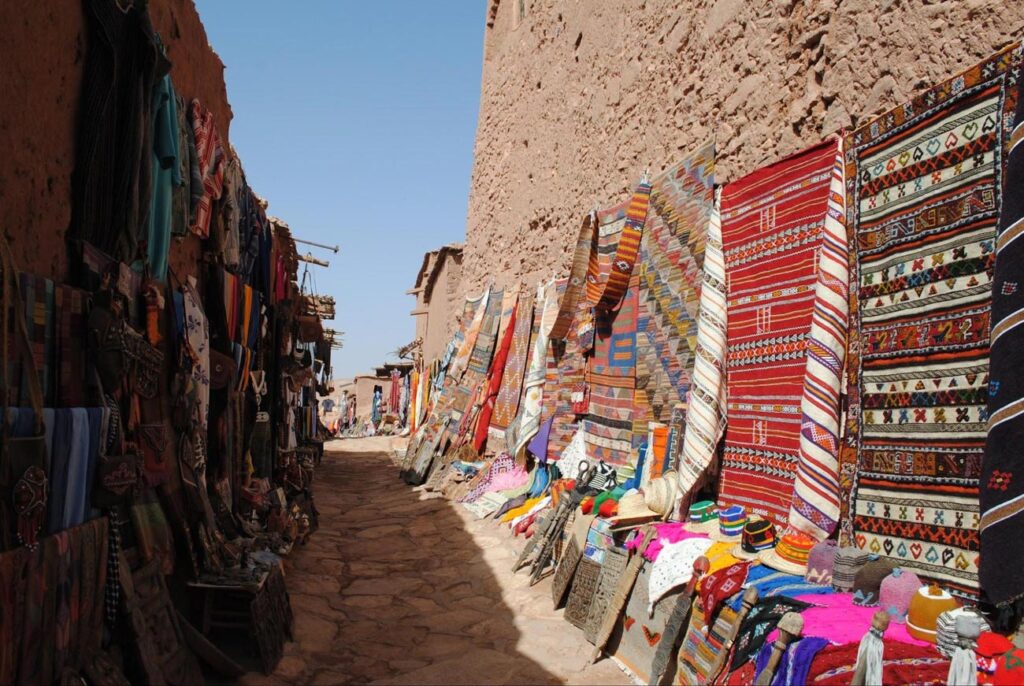
Passing along the streets you will see some houses which are detached from others. These are the kasbahs and there are about half a dozen of them in total. Some are open to visitors and can be toured. It costs 10 dirhams to enter and some are mini-museums. There are certain gift shops with wonderful paintings done with tea and saffron. They change their colour when exposed to heat and make great souvenirs, but don’t forget to haggle! Some of the shops sell fossils and crystals. If this is your thing, you might have a good time as the prices are generally much lower than in the big cities or Erfoud
From the citadel at the summit, you will have amazing views of the surrounding countryside well beyond the nearby hills. You can ascend from a tiny route that begins next to the 3rd entrance, and it is the perfect place to see the dusk from Ait Benhaddou.
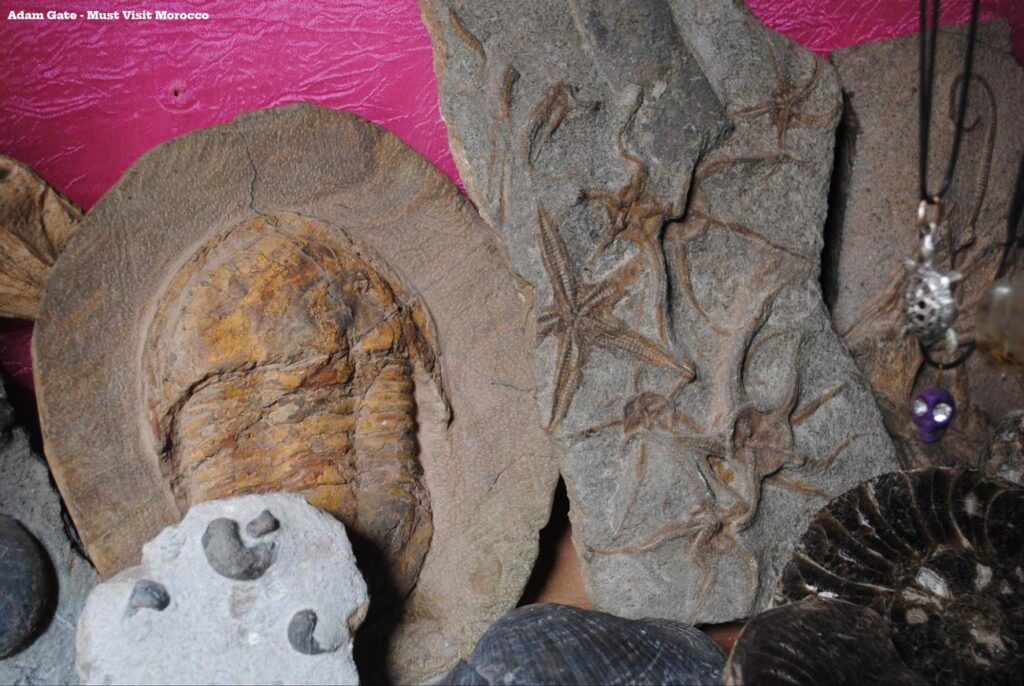
How to visit Ait Benhaddou in a Planned, Organised Group:
There are many planned, organised trips available from Marrakech, as well as other cities, which take in the famous sites and sights of southern Morocco including Ait Benhaddou.
From Marrakech here are some recommended excursions:
- One-day tour of Ait Benhaddou and Ouarzazate, including the film studios.
- Two Day Trip taking in Ait Benhaddou, the Draa Valley, and a night in the desert at the Erg Chegaga dunes.
- Three-day tour: Ait Benhaddou, Ouarzazate, the Dades, and Todra Gorges, and a night in the desert in the Erg Chebbi dunes.
- Four-day tour: Ait Benhaddou, Ouarzazate, the Dades, and Todra Gorges, a night in the desert at the Erg Chebbi dunes, Berber villages, and the Draa Valley.
Where to Stay in Ait Benhaddou:
Most visitors don’t stay the night in Ait Benhaddou, they just pass through, but if you decide to, it is best to reside in the new town on the opposite side of the river to the ancient Ksar. We resided at the La Baraka Hostel, which has ordinary, small rooms but all the luxuries. There are other Riads more luxurious in the neighbourhood but are more expensive.
Where to Eat in Ait BenHaddou:
There are plenty of restaurants. cafes and hotels to eat at, both in the Ksar and the new town. The Italian restaurant is nice, but a slightly more expensive option than some (150 dirhams for pizzas and pasta). We do recommend a Moroccan restaurant “The Hostel Valentine”. The food is excellent at a reasonable price – “110 and 120 dirhams, with salad or soup, main, fruit and tea”. In addition, it has a lovely patio and a very friendly and attentive owner. The Berber Tawesna tea house is also nice and worth a visit.
We hope that this article has been useful and will aid you in your visit to the most famous and best-preserved Ksar in Morocco.






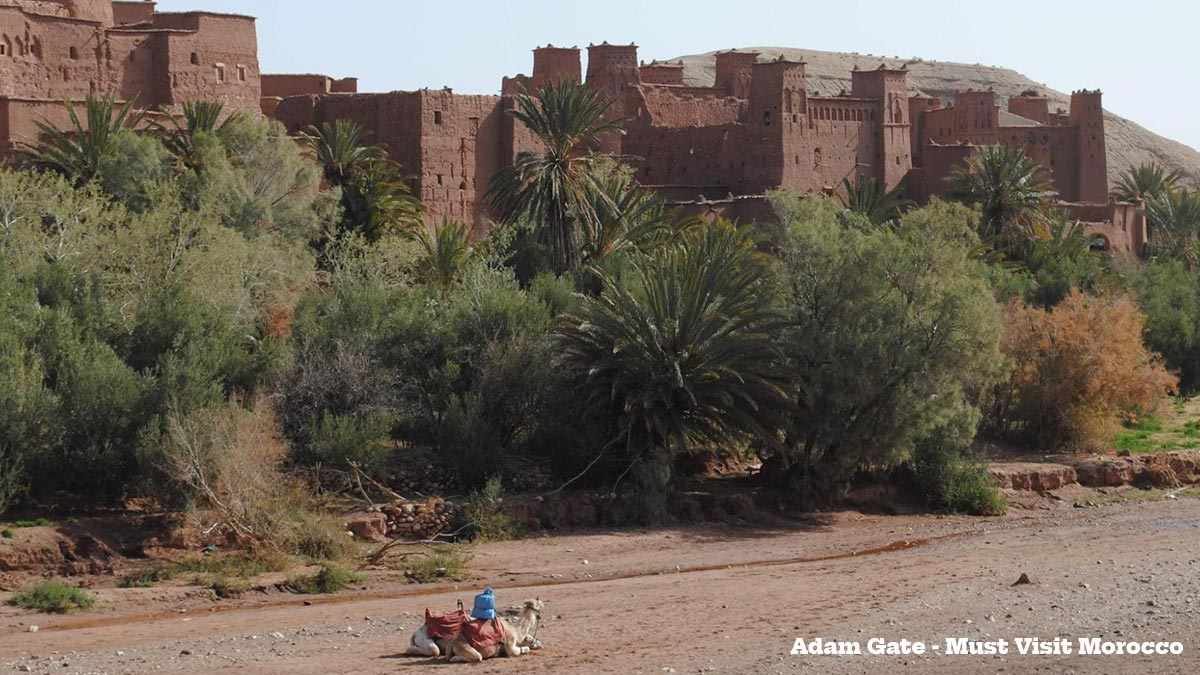
Hello 🙂 nice information, many thanks to the author. it is incomprehensible to me now, but in general, the usefulness and significance is overwhelming. thanks again and good luck!